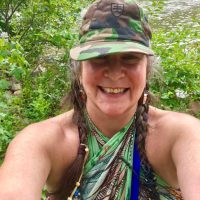*Editor’s Note: This piece is part of a series—lucky you! Follow Geri to get notified when the next article is available to read. And check out Part Two here.
~
When we first arrived, we thought our forest was perfect.
We spent months exploring the magical Eden, finding portals, creating altars where we could make offerings and hold sacred ceremonies in gratitude for the abundant gifts we received just being in its presence each day.
We never anticipated the realities of pests and pathogens to our Hemlock Hollow on the Cumberland Plateau of Tennessee.
In the Spring of 2021, we discovered our trees had been infested with a deadly pest identified as hemlock wooly adelgid (HWA). We were determined to provide competent guardianship and began the long journey to educate ourselves. A local arborist informed us this was one of the oldest groves of unharvested hemlock trees in our area, which further deepened our respect for the standing ones through all they had survived to still be here.
Unfortunately, we also came to understand that our forest was dying from this intruder.
The research was leading us into the world of science as we learned about the HWA, its threat to hemlock health, to the sustainability of hemlock forests across the eastern United States, and its potential threat to the entire ecosystem of not only the forests but also to aquatic life, wildlife, birds, and insects. The Hemlock Strikeforce Team sponsored by the Tennessee Hemlock Conservation Partnership recommended a chemical solution.
Armed with this information, we were faced with a decision.
We felt uncomfortable about the use of chemicals and troubled by the impact of our human involvement. I had resistance to using any type of chemicals. I visualized us in hazard suits stomping through the forest spraying a fog of insecticide and killing every living thing in our path.
So many questions arose about the recommended compound being introduced into the forest:
>> How would it affect the rest of the ecosystem?
>> Would it seep into the soil? Would it run into the creek?
>> What about our garden and the pollinators?
This led us on an odyssey of months more research as we questioned if we should intervene or let Mother Nature take her course without our interference.
I decided who better to ask for guidance than the hemlocks themselves.
My intuition kept telling me to go to the source and ask them what they want? I spent the entire day out in the forest seeking counsel, yet no response came.
Afterwards, I had a dream. A grandfatherly representative who spoke for all the hemlocks came to me and said, “We are the Alpha and the Omega. The beginning and the end. We were here before you and we will return after you. Even if we leave this land, we will return.”
These Hemlocks are not talkative trees and once they give an answer, you don’t keep asking them. They will just say: “We’ve already spoken. We have nothing else to say.” They are serious and succinct.
My research taught me it can take up to 200 years for a new hemlock forest to return. In the meantime, what happens to all the beings that are interdependent on this environment?
After several communications with the local—and extremely patient—Strikeforce Team Coordinator, and attending live demonstrations for private land holders, she convinced us the best thing we could do was to give what I now call “medicine” to the hemlocks. She took us on a local hike and showed us trees the team has been treating since 2013, and the miraculous recoveries they’ve been making.
She taught us the proper application using the direct-pour method around the base of the tree, after clearing the area of any debris or pollinators. Applying during the active season when the hemlocks are in “uptake” mode from the root system and when the HWA’s are most fertile, which is fall and spring. Also, not using any other method within 20 feet of a water body than direct injection to trees, so the water isn’t contaminated.
After seeing firsthand that the chemical solution has led to miraculous recoveries in other hemlock forests throughout the state, we changed our attitude not only of the solution itself, but also toward the scientists working to battle HWA throughout the region.
Now armed with knowledge, hope, and appreciation for the research of the teams we have met, we started working the land to heal our forest. We couldn’t just do nothing. It would be heart wrenching for us to sit by and watch the death of this habitat. Thanks in large part to my beloved partner, Mark, the healing has been incredible!
It was a decision of commitment by us to cover as much ground as we could afford, both financially and physically.
It was a decision to value and respect the local experts as they support and advise us in our work.
And it was, primarily, a gift of love and concern to the grandfathers and grandmothers who surround us and a commitment to all the wild creatures our hemlock hollow supports, which include us.
The hemlocks don’t need us, but we need them: to care for, to enjoy, to heal, and to learn from.
~
Please consider Boosting our authors’ articles in their first week to help them win Elephant’s Ecosystem so they can get paid and write more.
~


 Share on bsky
Share on bsky





Read 9 comments and reply